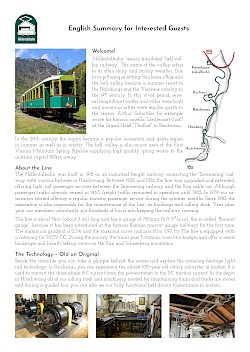About the railway
In 1917 a 5 km normal gauge connection from the Semmeringbahn at Payerbach to the little industry village Hirschwang should be built including a tunnel. The civil work company used a railway with 760 mm narrow gauge for material transportation with locomotives built 1903 and formerly used for construction of the Karawanken-tunnel. One year later, after end of World War I, the constructions were stopped and the tunnel was abandoned.
The industry in Hirschwang was furtheron linked by this little material railway and its funny electric locos only, until 1926, when Austria's first gondola ropeway to the Rax was opened. The material railway was reinforced and extended. Huge, then ultra-modern 4-axle motorcars with trailers were purchased. The so called "LBP-H" (Lokalbahnn Payerbach-Hirschwang) hauled millions of wanderers, ski-tourists, schoolkids and industry workers until 1963, when it was replaced by a bus line following those time's fashions.
In 1977 the "Austrian Light Rail Association" (OeGLB) was founded and established a museum railway service at the line, with freight trains still in service till the early 1980s.
Some technical data:
length: 5 km
gauge: 760 mm (so called "bosnian gauge")
max. gradient: 2.5 %
min. curve radius: 60 m
max. service speed: 20 km/h
catenary voltage: 500 V DC
energy supply: rotating and static AC-DC transformers
- E-loco E 1 built 1903, 2 axles, 2 x 18 kW
- EMU vehicle TW 1 built 1926, 4 axles, 4 x 28 kW
- 2 diesel locos and some motor railcars
- original EMU trailers 11 and 12
- self-adapted trailer 21 (from normal gauge trailer)
- many freight wagons used for internal transports
You can find photos and detailled infos of the rolling stock in our german rolling stock section and detailled infos of the line in our german railway line section and our german railway buildings section.
Today, the railway is maintained and operated by a small group of volunteers in their freetime and service is thus limited to sundays and holydays during summer. In addition to the train rides, guided tours show vehicles and technical devices as well as the work of the volunteers from the backstage view.
Attracting thousands of visitors every year, the Hoellentalbahn is a lovingly preserved technical monument embedded in a charming landscape.
Enjoy yourself!



